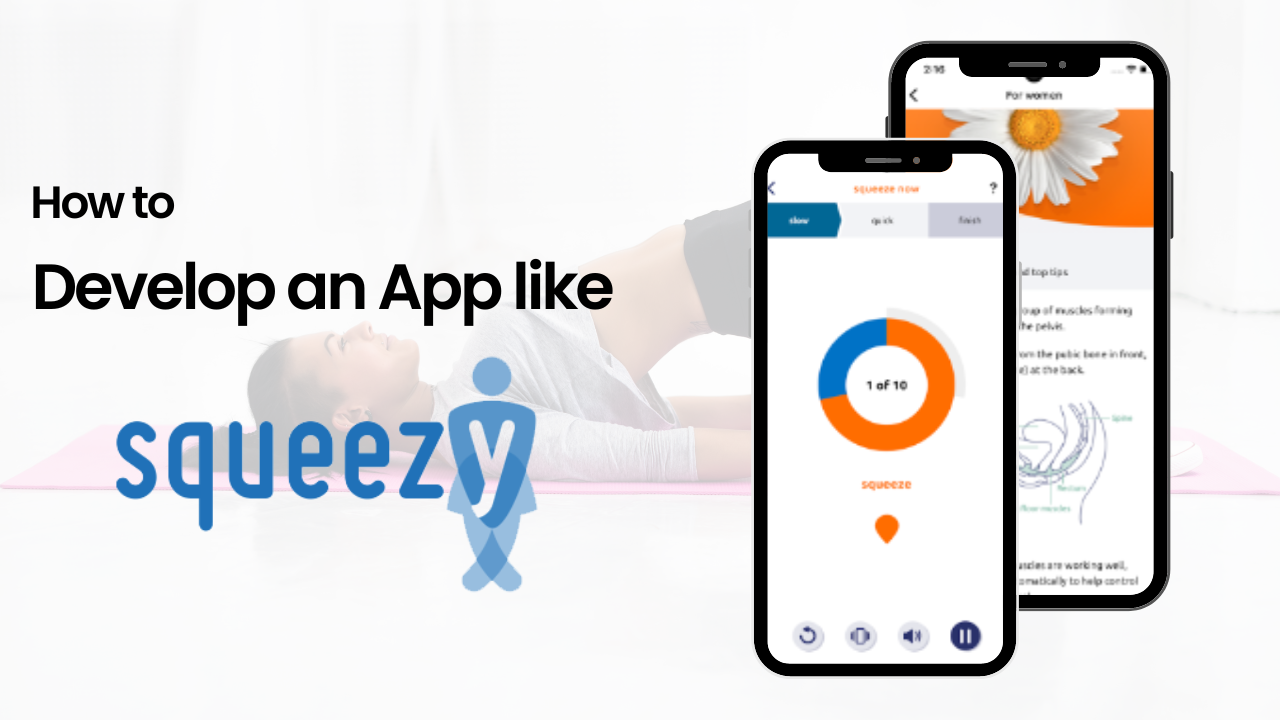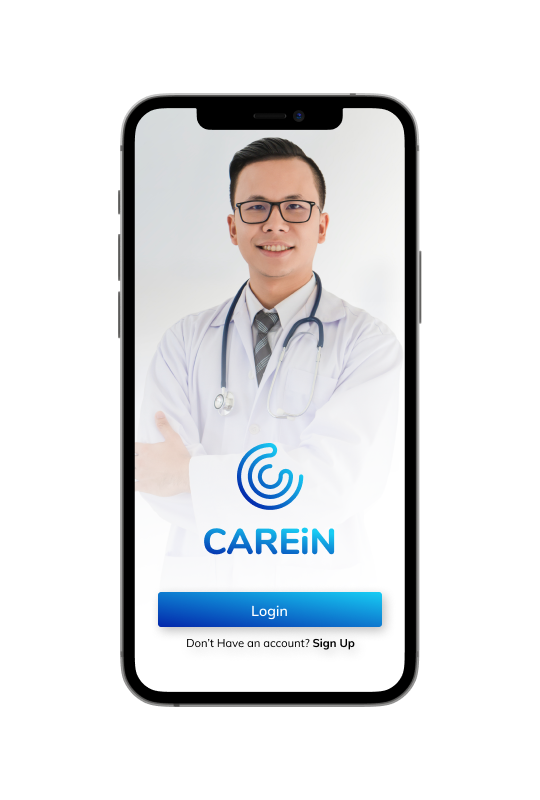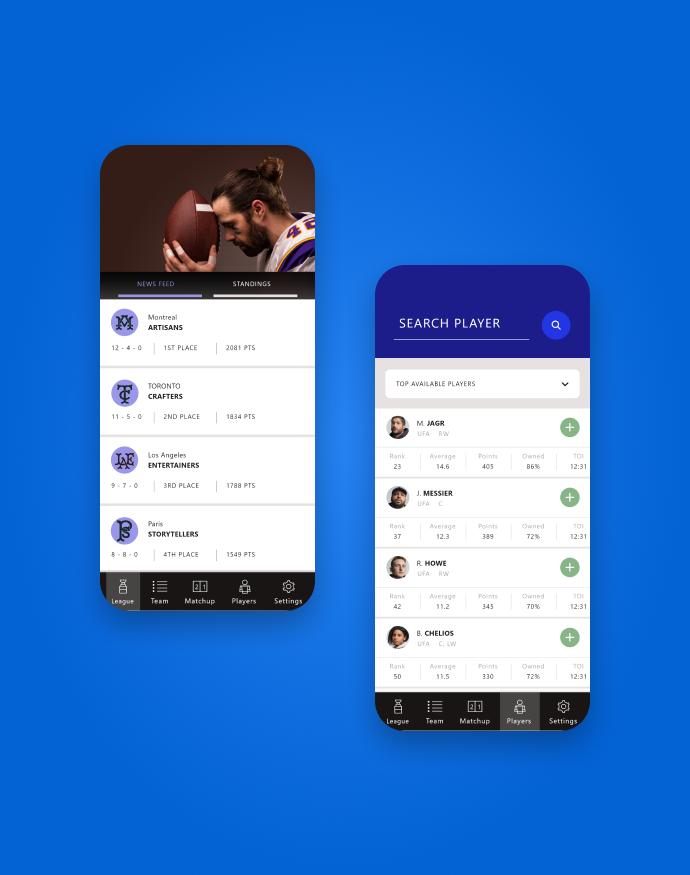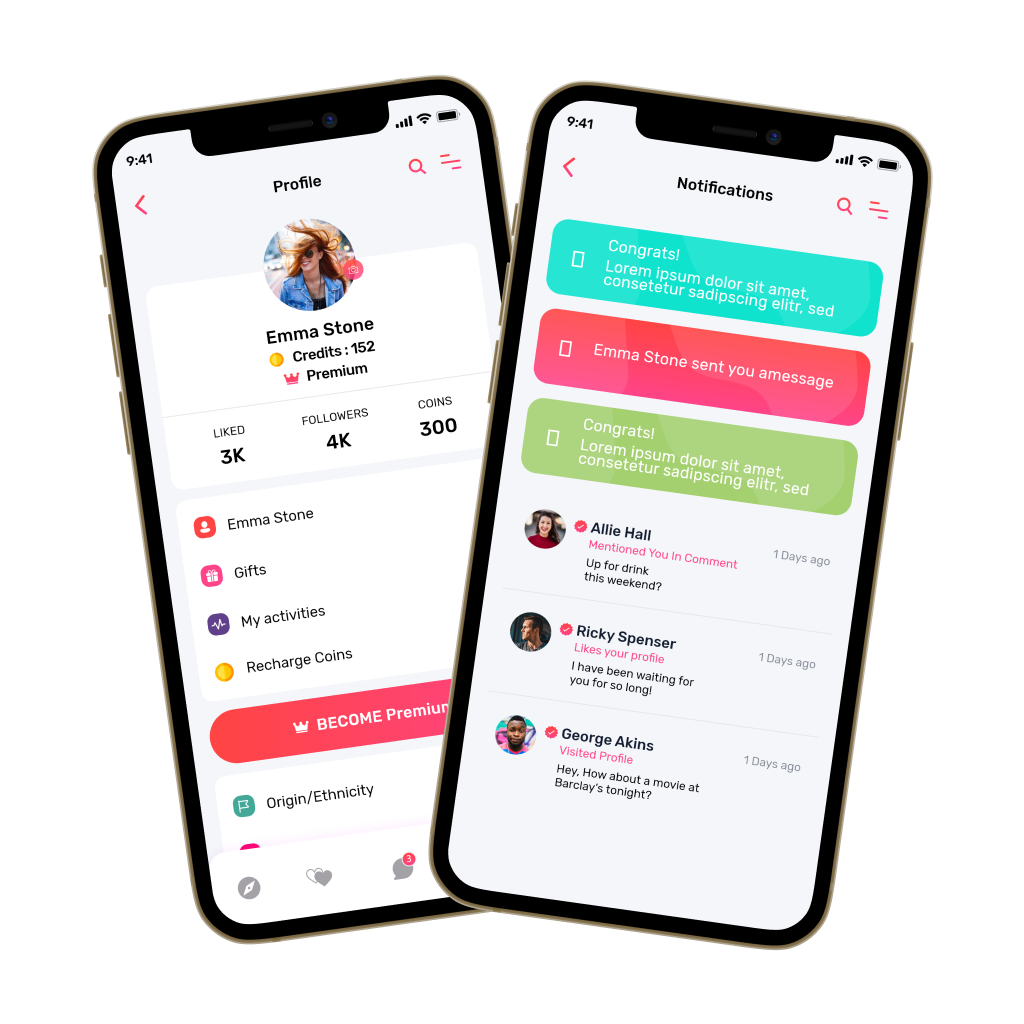- What is Squeezy App ?
- How does an App Like Squeezy Works?
- Key Market Analysis
- How to Develop an App Like Squeezy?
- Must Have Features for an App Like Squeezy
- Factors Affecting the Development Cost of an App Like Squeezy
- Essential Tech-Stack Needed to Develop an App Like Squeezy
- Top 5 Apps Like Squeezy in the Market
- Conclusion
- Frequently Asked Questions

In today’s fast-paced world, where digital technology is seamlessly integrated into our daily lives, mobile applications have emerged as powerful tools for promoting health and well-being. Among these, apps dedicated to specific health concerns, apps like Squeezy, which focuses on pelvic floor health, have gained immense popularity. If you’re inspired by the impact of such women’s health apps and considering embarking on a similar journey, this guide will walk you through the essential steps to develop an app like Squeezy.
From ideation to execution, we’ll explore the key considerations and best practices that will help you create a user-friendly and effective app, empowering users to take charge of their pelvic health and overall well-being.
- What is Squeezy App ?
- How does an App Like Squeezy Works?
- Key Market Analysis
- How to Develop an App Like Squeezy?
- Must Have Features for an App Like Squeezy
- Factors Affecting the Development Cost of an App Like Squeezy
- Essential Tech-Stack Needed to Develop an App Like Squeezy
- Top 5 Apps Like Squeezy in the Market
- Conclusion
- Frequently Asked Questions
What is Squeezy App ?
Squeezy App is a pelvic health mobile application designed to assist and guide individuals in performing pelvic floor muscle exercises effectively. Developed with a focus on improving pelvic health, particularly for those dealing with issues like urinary incontinence or pelvic organ prolapse, the app offers a user-friendly interface and step-by-step instructions for targeted exercises. Users can set personalized exercise plans and receive reminders, making it easier to incorporate pelvic floor exercises into their daily routine.
Additionally, Squeezy App tracks progress and provides valuable feedback to help users monitor their improvement over time. With its specialized approach and accessibility, Squeezy App has become a valuable tool for promoting pelvic health and overall well-being.
How does an App Like Squeezy Works?
Let’s take a closer look at how this app works and how it assists users in improving their pelvic health.
User Profile and Assessment:
Upon downloading the Squeezy App, users are prompted to create a personalized profile. The app gathers information about their pelvic health concerns, medical history, and exercise preferences. Additionally, users may undergo a self-assessment, answering a series of questions that help the app understand their current pelvic floor condition and identify areas of improvement.
Customized Exercise Plans:
Based on the information gathered during the assessment, the app generates a tailored exercise plan for each user. These exercises specifically target the pelvic floor muscles and are designed to meet the user’s individual needs and capabilities. Squeezy App ensures that users receive exercises suitable for their condition and fitness level, promoting safety and efficacy.
Instructional Videos and Guides:
The app provides clear and detailed instructional videos and guides for each exercise in the user’s plan. These visual aids are invaluable, as they demonstrate the correct techniques and positions for performing pelvic floor exercises accurately. Proper form is crucial for optimal results as well as to avoid potential injuries, and the app ensures users have access to expert guidance at their fingertips.
Reminders and Progress Tracking:
Consistency is key when it comes to pelvic floor exercises. To help users stay on track, Squeezy App offers customizable reminders. Therefore, users can set up daily or weekly alerts, consequently, ensuring they never miss a session. Moreover, the app enables users to track their progress over time. Regularly recording exercise completion and monitoring improvements motivates users as well as provides a sense of achievement.
In-App Support and Resources:
For individuals who may have questions or need additional information, the app often includes a support section. Here, users can find answers to common queries or access additional resources related to pelvic health. Some apps may even have links to reputable websites, articles, or professional advice to further enhance user knowledge.
Privacy and Security:
Given the sensitive nature of pelvic health, user privacy and data security are paramount. Reputable apps like Squeezy implement robust security measures to protect user information. Therefore, they may include options for password protection, encryption, and adherence to strict data protection policies, thus, ensuring user data remains confidential.
Updates and Enhancements:
Quality apps like Squeezy are continuously evolving. Developers regularly update the app to include the latest research-based exercises, features, and improvements based on user feedback. These updates ensure that users have access to the most effective and user-friendly pelvic floor exercise experience.
Key Market Analysis
The global mHealth apps market has witnessed remarkable growth in recent years, with a significant value of USD 43.5 billion recorded in 2022. Projections indicate a promising future, with an expected compound annual growth rate (CAGR) of 11.6% from 2023 to 2030. Among the diverse array of health apps, those dedicated to pelvic health, such as Squeezy, have emerged as key players in this expanding market.
Credit: Grand View Research
Let’s explore the key market takeaways of health apps like Squeezy and why developing such apps holds immense potential for the future.
Rising Adoption and Data Collection:
The increasing adoption of fitness and medical apps reflects a growing awareness among individuals regarding the importance of monitoring and managing their health. Health apps like Squeezy empower users to collect and track vital health-related data, particularly in the context of pelvic floor health. As users become more proactive in their well-being, consequently, the demand for specialized apps catering to specific health needs is expected to rise.
Enhanced Patient Care and Engagement:
Health apps offer unprecedented convenience as well as accessibility, thus, providing patients with valuable tools to manage their conditions proactively. Squeezy and similar apps enable users to access personalized exercise plans, instructional videos, as well as progress tracking, thus, promoting regular engagement in pelvic floor exercises. Improved patient engagement can lead to better adherence to treatment plans and overall health outcomes.
Smartphone Integration Driving Growth:
The widespread use of smartphones acts as a catalyst for the growth of mHealth apps. With smartphones becoming an integral part of daily life, health apps have the advantage of being easily accessible to a broad user base. The convenience of accessing pelvic health exercises on-the-go makes it more likely for users to integrate such apps into their routines, ultimately contributing to market expansion.
Empowering Users with Self-Care:
Health apps like Squeezy empower individuals to take charge of their health, promoting self-care and autonomy. By providing personalized exercise plans and instructional resources, these apps equip users with the knowledge and tools to manage their pelvic health effectively. This shift towards proactive self-care not only benefits individual users but also reduces the burden on healthcare systems.
Potential for Future Innovations:
As the mHealth apps market continues to grow, developers are likely to invest in further research and innovation to enhance the user experience and app effectiveness. Advancements in technology, such as integrating wearable devices or leveraging artificial intelligence for personalized recommendations, hold exciting prospects for the future of pelvic health apps and the broader mHealth sector.
How to Develop an App Like Squeezy?
The success of health apps like Squeezy, focused on promoting pelvic floor health, has inspired many entrepreneurs and developers to explore the possibility of creating similar applications. If you’re considering developing an app like Squeezy, here’s a step-by-step guide to help you get started:
Market Research and Idea Validation:
Begin by conducting thorough market research to understand the demand for pelvic health apps and identify potential competitors. Gather feedback from target users to validate your app idea and identify specific pain points you can address.
Define the App’s Features and Functionality:
Based on your research and user feedback, outline the features and functionalities your app will offer. This may include personalized exercise plans, instructional videos, progress tracking, reminders, and a user-friendly interface.
Collaborate with Healthcare Professionals:
For an app that focuses on health and wellness, collaborating with healthcare professionals, particularly experts in pelvic health, is crucial. Seek advice from doctors, physical therapists, or specialists to ensure your app’s exercises and content are accurate and safe.
Design the User Interface (UI) and User Experience (UX):
Create a visually appealing and intuitive UI/UX design that enhances user engagement. Consider using color schemes and visuals that resonate with your target audience while maintaining a user-friendly layout.
Choose the Right Technology Stack:
Select the appropriate technology stack for your app’s development. Decide whether you’ll develop a native app (iOS and Android) or opt for cross-platform development frameworks like React Native or Flutter to expedite the process.
Build a Prototype:
Create a basic prototype to visualize the app’s flow and functionalities. Prototyping allows you to test the app’s core features and make improvements before investing in full development.
Develop the App:
With a clear plan and prototype in place, start the development process. Work with skilled developers to bring your app to life, ensuring it functions seamlessly across different devices and operating systems.
Implement Personalization and Data Security:
Incorporate personalized exercise plans and progress tracking features. Additionally, prioritize data security to protect user information and comply with relevant privacy regulations.
Test and Quality Assurance:
Perform rigorous testing and quality assurance to identify and resolve any bugs or issues. User testing and feedback during this phase can provide valuable insights for further enhancements.
Launch and Marketing Strategy:
Prepare a comprehensive marketing strategy to launch your app effectively. Utilize social media, online advertising, and collaborations with influencers or healthcare professionals to promote the app.
Gather User Feedback and Iteration:
Encourage users to provide feedback and reviews after the app’s launch. Use this feedback to make necessary improvements and iterate the app’s features for continued user satisfaction.
Monitor Analytics and Performance:
Implement analytics to monitor user behavior and app performance. Analyzing data will help you identify usage patterns, popular features, and areas that may require further optimization.
Must Have Features for an App Like Squeezy
When developing an app dedicated to pelvic health, such as Squeezy, it’s essential to include features that provide a comprehensive and user-friendly experience. To ensure your app effectively addresses the needs of users and contributes to better pelvic health, here are some must-have features to consider:
Personalized Exercise Plans:
A key feature of an app like Squeezy is the ability to create personalized exercise plans tailored to each user’s specific needs. These plans should be based on the user’s pelvic health assessment, medical history, and fitness level. The app should offer a range of exercises, each with clear instructions and demonstrations.
Instructional Videos and Guides:
To guide users through their exercises effectively, provide instructional videos and step-by-step guides. Visual aids enhance understanding and ensure users perform exercises with the correct techniques and postures, maximizing the benefits while reducing the risk of injury.
Progress Tracking and Analytics:
Allow users to monitor their progress over time. Implement tracking features that record exercise completion, frequency, as well as any improvements in pelvic health. Analytics can provide insights into user engagement as well as the effectiveness of the app’s features.
Reminders and Notifications:
Consistency is vital for pelvic floor exercises. Incorporate reminders and notifications to prompt users to perform their exercises regularly. Customizable settings, such as setting exercise schedules and frequency, empower users to stay on track.
Data Privacy and Security:
Ensure the app adheres to strict data privacy and security measures. As pelvic health is a sensitive subject, therefore, users must trust that their personal information and health data are safeguarded.
Collaboration with Healthcare Professionals:
Consider integrating features that allow users to share their progress with healthcare professionals, such as physical therapists or doctors. This collaboration fosters better communication and ensures that the app aligns with professional guidance.
User Support and Resources:
Include a support section where users can access frequently asked questions, troubleshooting guides, as well as additional resources related to pelvic health. Offering user support enhances the overall app experience and addresses common queries.
In-App Community and Engagement:
Facilitate a sense of community among users by incorporating social elements. A discussion forum or chat feature can enable users to share experiences, tips, and encouragement, thus, fostering engagement as well as motivation.
Offline Access to Exercises:
Enable offline access to exercise plans and instructional content. This feature allows users to continue their pelvic floor exercises even when they don’t have internet connectivity, promoting consistent engagement.
Gamification and Rewards:
To make the app more engaging and enjoyable, consider implementing gamification elements. Achievements, milestones, as well as rewards for regular exercise completion can motivate users to stay committed to their pelvic health journey.
Accessibility and Inclusivity:
Ensure the app is accessible and inclusive to users of all abilities. Features like adjustable font sizes, voice-guided exercises, as well as language options can enhance the app’s usability for a broader audience.
Factors Affecting the Development Cost of an App Like Squeezy
Developing an app like Squeezy, dedicated to promoting pelvic health, involves meticulous planning and investment. The cost of app development can vary significantly based on various factors that influence the complexity and scope of the project. Here, we explore the key factors that affect the development cost of an app like Squeezy:
Feature Set and Functionality:
The number and complexity of features play a vital role in determining the development cost. Features like personalized exercise plans, instructional videos, progress tracking, reminders, and user support will require more time and effort to implement, impacting the overall cost.
Design and User Interface (UI/UX):
A visually appealing and intuitive UI/UX design is crucial for user engagement. A well-designed app that aligns with the app’s theme and brand identity may require higher design costs, particularly if you hire experienced designers.
Platforms and Devices:
The choice of platforms and devices (iOS, Android, cross-platform) on which the app will be available affects the development cost. Therefore, developing for multiple platforms or ensuring compatibility with various devices may increase expenses.
Development Team and Expertise:
The size and expertise of the development team influence the overall cost. Hiring skilled developers, designers, and testers with experience in mHealth apps may be more expensive, but it ensures a high-quality product.
Integration with Healthcare Professionals:
If your app includes features for collaboration with healthcare professionals or involves integrating third-party APIs for data exchange, this consequently add up to the development cost.
Data Security and Compliance:
Building robust data security measures and ensuring compliance with relevant regulations require careful attention. However, implementing security features and obtaining necessary certifications may impact the development cost.
Testing and Quality Assurance:
Rigorous testing and quality assurance are essential to deliver a bug-free and smooth user experience. Allocating sufficient resources for testing might influence the overall development cost.
App Maintenance and Updates:
Post-launch, apps like Squeezy require regular maintenance as well as updates to keep them functional and relevant. Factoring in ongoing maintenance costs is crucial for the app’s long-term success.
Geographic Location of Development Team:
The geographic location of the development team can influence costs significantly. Therefore, hiring a team from regions with higher labor costs may be more expensive compared to teams from regions with lower rates.
Marketing and Promotion:
The cost of marketing and promoting the app to reach a wider audience and gain traction in the market is an essential consideration for the overall budget.
Essential Tech-Stack Needed to Develop an App Like Squeezy
Building an app like Squeezy, focused on promoting pelvic floor health, requires the right combination of technologies to ensure a seamless as well as efficient user experience. Here are the essential components of the tech-stack needed to develop an app like Squeezy:
Programming Languages
- Swift (iOS): Swift is the primary programming language for developing iOS apps. It offers clean syntax, robust performance, and excellent support for Apple’s frameworks and APIs.
- Kotlin (Android): Kotlin is the preferred language for Android app development due to its concise syntax, compatibility with Java, and its ability to enhance productivity.
Integrated Development Environment (IDE)
- Xcode (iOS): Xcode is Apple’s official IDE for iOS app development. It offers a comprehensive set of tools, including a code editor, simulator, and debugging features.
- Android Studio (Android): Android Studio is the official IDE for Android development, providing tools for coding, testing, and optimizing Android apps.
User Interface (UI) and User Experience (UX)
- Interface Builder (iOS): Interface Builder allows developers to design UI elements visually for iOS apps. It simplifies UI creation and speeds up the development process.
- XML Layouts (Android): Android apps use XML layouts to define the UI components and their arrangement. It provides flexibility in designing responsive interfaces.
Database Management
- Core Data (iOS): Core Data is Apple’s framework for managing the app’s data model and local storage on iOS devices.
- SQLite (Android): SQLite is a lightweight database engine that provides local data storage for Android apps.
Backend Development:
- Server-Side Framework: Choose a server-side framework (e.g., Node.js, Ruby on Rails, Django) to handle data processing, user authentication, and manage the app’s backend functionality.
- APIs (Application Programming Interfaces): Create APIs to enable communication between the app and the server, allowing seamless data exchange.
Cloud Storage:
- Amazon S3, Google Cloud Storage, or Firebase Cloud Storage: Use cloud storage services to store media files, such as exercise videos or images, ensuring efficient content delivery to the app.
Push Notifications:
- APNs (Apple Push Notification Service): For iOS, integrate APNs to send push notifications and reminders to users’ devices.
- FCM (Firebase Cloud Messaging): For Android, FCM enables push notifications and real-time messaging capabilities.
Security and Data Protection
- SSL Certificates: Implement SSL certificates to secure data transmission between the app and server, ensuring data privacy.
- Token-Based Authentication: Use token-based authentication to protect user data and enhance app security.
Analytics and Crash Reporting
- Firebase Analytics: Firebase Analytics provides valuable insights into user behavior and app performance.
- Crashlytics: Crashlytics offers real-time crash reporting to identify and fix app crashes swiftly.
Payment Gateway (Optional)
- Stripe, PayPal, or Apple Pay: If the app offers in-app purchases or subscription services, integrate a secure payment gateway for smooth transactions.
In conclusion, the tech-stack for developing an app like Squeezy requires a careful selection of programming languages, development environments, databases, backend frameworks, as well as additional tools for enhanced user experience and data security. By employing the right technologies, developers can build a robust and user-friendly app that empowers users to take control of their pelvic health and thus, improve their overall well-being.
Top 5 Apps Like Squeezy in the Market
Sure, here are the top 5 apps like Squeezy in the market:
Kegel Trainer
Kegel Trainer is a free app that helps you strengthen your pelvic floor muscles. It includes a variety of exercises, as well as a progress tracker.
Fit Mom
Fit Mom is a paid app that offers a variety of features to help you improve your pelvic floor health. These features include exercises, relaxation techniques, as well as a community forum.
Pelvic Floor PT
Pelvic Floor PT is a paid app that is designed by physical therapists. It includes a variety of exercises, as well as a progress tracker.
Kegels Exercise For Women
Kegels Exercise for Women is a free app that helps you track your progress and stay motivated. It includes a variety of exercises as well as a progress tracker.
Pelvic Floor Exercise
Pelvic Floor Exercise is a free app that includes a variety of yoga poses that can help you strengthen your pelvic floor muscles.
Conclusion
Developing an app like Squeezy is a journey that requires dedication, empathy, and an unwavering commitment to promoting pelvic health. By following the essential steps outlined in this guide, you can lay a strong foundation for your app’s success. Remember to conduct thorough market research, collaborate with healthcare professionals, as well as prioritize user experience throughout the development process. As you design personalized exercise plans, integrate instructional videos, and implement progress tracking features, envision the impact your app will have on empowering users to improve their pelvic health as well as quality of life.
At IdeaUsher, we are dedicated to transforming the landscape of pelvic health through our exceptional app development services. Just like the successful app Squeezy, our journey is driven by an unwavering commitment to promoting pelvic health, empowering individuals to lead healthier as well as happier lives.
Reach out to us today to commence a conversation about your project requirements.
Frequently Asked Questions
1. What is the main focus of an app like Squeezy?
An app like Squeezy is specifically designed to promote pelvic floor health. It offers personalized exercise plans, instructional videos, as well as progress tracking features to help individuals improve their pelvic health and address concerns like urinary incontinence or pelvic organ prolapse.
2. Is Squeezy suitable for all users, regardless of fitness level?
Yes, Squeezy app caters to users of all fitness levels. The app conducts a pelvic health assessment during onboarding to create personalized exercise plans tailored to each user’s individual needs as well as capabilities.
3. How can Squeezy maintain user privacy and data security?
Squeezy prioritizes user privacy and data security by implementing robust measures such as encryption, secure data storage, and adherence to relevant data protection regulations. Therefore, users can trust that their personal health information is kept confidential.
4. Can healthcare professionals be involved in the Squeezy app experience?
Yes, Squeezy offers features that allow users to collaborate with healthcare professionals. Users can share their progress as well as exercise data with doctors or physical therapists, thus, enabling a more comprehensive approach to pelvic health management.













Yuvraj Singh